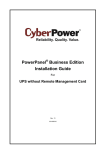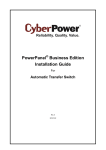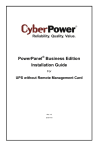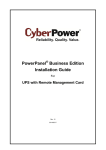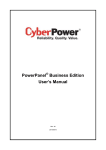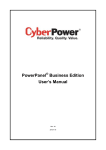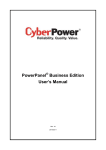Download CyberPower PowerPanel Installation guide
Transcript
PowerPanel® Business Edition Installation Guide For Power Distribution Unit Rev. 14 2014/09/10 Table of Contents Introduction ...................................................................................................................................................... 3 Hardware Installation ...................................................................................................................................... 3 ® Install PowerPanel Business Edition Software........................................................................................... 4 Installation on Windows ................................................................................................................................. 4 Installation on Linux ....................................................................................................................................... 6 Installation on Text Mode .......................................................................................................................... 9 Installation on VMware ESXi and ESX .......................................................................................................... 9 Installation on ESXi ................................................................................................................................... 9 Installation on ESX .................................................................................................................................. 10 Virtual Appliance Deployment on ESXi ....................................................................................................... 10 Installation on XenServer ............................................................................................................................ 14 Installation on Hyper-V Server .................................................................................................................... 14 ® Access PowerPanel Business Edition Software Interface ...................................................................... 15 Manage PDUs in Center ................................................................................................................................ 15 Add PDUs .................................................................................................................................................... 15 Configure Power Protection for Computer ................................................................................................. 16 Assign PDU’s IP Address and Connected Outlet in Client .......................................................................... 16 Setup Necessary Shutdown Time ............................................................................................................... 17 Configure Shutdown Action for ESXi ........................................................................................................... 17 Configure Startup and Shutdown of Virtual Machines on ESX/ESXi .......................................................... 18 Configure Shutdown of Virtual Machines on Hyper-V Server ..................................................................... 19 Mass Deployment .......................................................................................................................................... 20 2 Introduction A Power Distribution Unit (PDU) provides power output controls for individual outlets to your connected ® equipment. The PDU can establish communication with PowerPanel Business Edition Center via the network. It can relay its state to Center and accepts commands to turn off or turn on the outlets. When the ® PDU turns off an outlet, any connected computers running PowerPanel Business Edition Client are shut down in an orderly fashion, preventing data loss or a system crash due to an immediate power loss. Refer to the illustration below. ® PowerPanel Business Edition Center allows the administrator to simultaneously monitor the status and events from multiple PDUs. Center establishes communication with multiple PDUs via the network and sends commands to each PDU to turn off or turn on the outlets. The powered computers which have installed the Client will initiate shutdown sequences prior to turning off outlets. ® PowerPanel Business Edition software can be installed on various platforms including Windows, Linux, Citrix XenServer and VMware ESX/ESXi. Following sections describe conditions specific to these platforms individually. Hardware Installation ® Before installing PowerPanel Business Edition software, make sure that the following hardware installations are configured properly: Verify the computer’s power is connected to the PDU outlet properly. Verify the computer’s network is connected. Verify the PDU’s network is connected. Please refer to the Power Distribution Unit User's Manual for a proper hardware installation. 3 Install PowerPanel® Business Edition Software Installation on Windows ® A popup page will be displayed automatically when inserting the PowerPanel Business Edition installation CD. Users can click the Install PowerPanel Business Edition software shortcut on the popup page to initiate the installation procedure. If the popup page is not displayed when inserting the CD, browse to the CD drive and open the folder which locates at /Software/Windows, and then double click the file named Setup.exe to start the installation procedure. To install follow these steps: Click the Next button to start an installation. Accept the license agreement. Choose the component. In order to monitor multiple PDUs, Center should be installed. In order to monitor on a single computer powered by the PDU, Client should be installed. Note: Agent should not be selected because of ability to access to UPS instead of PDU. 4 Choose the destination directory. Choose the start menu folder. 5 Click the Finish button to complete the installation. Installation on Linux The installer requires root permission to install the Client. The installation wizard will guide users to complete the installation. Initiate an installation wizard by running the ./ppbe-linux-x86.sh command or double clicking ppbe-linux-x86.sh from the desktop on 32-bit systems. Initiate an installation wizard by running the /.ppbe-linux-x64.sh command or double clicking ppbe-linux-x64.sh from desktop on 64-bit systems. Note: On Linux systems, users may mount the CD by use the mount command. Execute mount –t iso9660 /dev/cdrom /mnt/cdrom as a root user. /dev/cdrom is the CD drive and /mnt/cdrom will be the mount point. To install follow these steps: Click the Next button to start an installation. Accept the license agreement. 6 Choose the component. In order to simultaneous monitor multiple PDU, the Center should be installed. If one single computer which is powered by the PDU requiring protection, the Client should be installed. Note: Agent should not be selected because of ability to access to UPS instead of PDU. Choose the destination directory. 7 The daemon ppbed will start during installation. Click the Finish button to complete the installation. 8 Installation on Text Mode When the system does not support graphic mode, the Linux installation needs to be initiated in the terminal by using the ./ppbe-linux-x86.sh -c command on 32-bit systems or use ./ppbe-linux-x86_64.sh -c command on 64-bit systems. The installation procedure will be initiated as following steps: Press Enter to start an installation. Accept the license agreement. Choose the component. In order to simultaneous monitor multiple PDU, Center should be installed. If one single computer which is powered by the PDU requiring protection, Client should be installed. Note: Agent should be not selected because of ability to access to UPS instead of PDU. Choose the destination location. Installation procedure starts and once finished. It will end automatically. Installation on VMware ESXi and ESX Installation on ESXi Installation must be launched in the vMA (vSphere Management Assistant) which is also a virtual machine on the ESXi host. In order to deploy vMA on the ESXi host and install PPBE in the vMA, users must install the vSphere Client tool on another remote computer first. To download the vSphere Client installer, users can 9 enter the ESXi host IP address to access the web page. Users can visit VMware website for vSphere Management Assistant Guide document about vMA deployment on VMware ESXi. The installer will guide users in completing the installation. Refer to Installation on Text Mode section to follow the same steps to complete installation. The installer requires root permission to initiate the installation procedure. Mount CD by running mount -t iso9660 /dev/cdrom /mnt/cdrom as a root user.(/dev/cdrom is the CD drive and /mnt/cdrom will be the mount point.). Browse the CD drive and find the installer in the /Software/Linux folder. Initiate an installation procedure by running the ./ppbe-linux-x86_64.sh command. Note: In order to allow the interactions between physical and virtual machines, VMware tools have to be installed on each virtual machine. Refer to VMware ESX/ESXi Server documentation for further information about VMware Tools. Installation on ESX Installation must be launched in the Service Console (aka Console Operation System). To initiate the installation procedure on VMware ESX also requires root permission. Use the same command to mount CD and initiate the installation procedure. Refer to Installation on Text Mode section to complete the installation. Virtual Appliance Deployment on ESXi A virtual appliance (VA) is a prebuilt software solution, comprised of one or more virtual machines that is packaged, maintained, updated and managed as a unit. It is fundamentally changing how software is developed, distributed, deployed and managed. Download the PPBE virtual appliance which is pre-installed Client from CyberPower. In order to deploy the PPBE virtual appliance on VMware ESXi host, users must install vSphere Client tool first on another remote computer. To download the vSphere Client installer, users can enter the ESXi host IP address to access web page of ESXi host. The deployment procedure will be initiated as below steps: Launch the vShpere Client. Open the Deploy OVF Template window from File > Deploy OVF Template… item. 10 Click Browse to import the ppbeXXX_centos.ovf extracted from the download zip file. Click Next to start a deployment task. The OVF template detail is displayed. Click Next to continue. Enter the name for the deployed PPBE virtual appliance. This name should be unique within the inventory. 11 Select the virtual disk format for the PPBE virtual appliance. The default option is Thin Provision. Refer to About Virtual Disk Provision Disk Policies for further information about how to select virtual disk format. A deployment detail is displayed. Click Finish to start the deployment task. 12 After the deployment task is complete, the PPBE virtual appliance will be added into the inventory. Click Power on the virtual machine to power on the virtual machine and ready to access the Agent. Login the virtual appliance. The default username and password are admin. In order to perform shutdown 13 accurately, you must change the time zone settings of the virtual appliance. This can be a direct copy of the time zone file from the /usr/share/zoneinfo folder. We assume that the host is located under the Chicago CST zone in Chicago, and the time zone can be changed by running the command cp /usr/share/zoneinfo/America/Chicago /etc/localtime. Installation on XenServer ® The installer requires root permission to install the PowerPanel Business Edition. Mount CD by running mount -t iso9660 /dev/cdrom /mnt/cdrom as a root user (/dev/cdrom is the CD drive and /mnt/cdrom will be the mount point.). Browse the CD drive and run ./ppbe-linux-x86.sh command to initiate an installation procedure. Installation must be launched on the Dom0. Refer to Installation on Text Mode section to complete the installation. Installation on Hyper-V Server ® Use the PowerPanel Business Edition installation CD to complete the installation on the target computer. Run the <CD_Drive>\Software\Windows\setup.exe of the command prompt such as below illustration to start the installation procedure (CD_Drive is a CD drive formatted as D: or E:). A popup window will be displayed when the installation is launched. Refer to Installation on Windows section to follow the same steps to complete installation. Access PowerPanel® Business Edition Software Interface ® To access the PowerPanel Business Edition interface in Windows, go to Start > All Programs > CyberPower PowerPanel Business Edition > PowerPanel Business Edition Center (or PowerPanel 14 Business Edition Client) which will take you to the login page. On Linux, users can also enter the URL as http://localhost:3052/ in the address of the web browser to access to the interface. Users can also enter the URL, http://hosted_computer_ip_address:3052/ in the address of the web browser to access the interface from a remote computer. hosted_computer_ip_address ® is the IP address of the computer which has the PowerPanel Business Edition installed. For vMA on the ESX or ESXi, hosted_computer_ip_address is the IP address of the vMA (Note: hosted_computer_ip_address is the IP address of the host computer on ESX.) The default username is admin and default password is admin. For security purposes, it is recommended you change the login username and password after the initial login. ® PowerPanel Business Edition supports multiple-language function and allows users to change language. It will choose the suitable language as the default one to display at the initial access. Users can change the language from the banner. After the language is changed, the page will refresh automatically and choose the assigned language as the default one to display. Manage PDUs in Center Add PDUs Users can monitor and control multiple PDUs on the Management/Power Equipment page by accessing Add Device window in the context menu to add PDUs in Center as below: The Add Device window can be accessed by clicking the Add Device button of the toolbar or selecting the Add Device of the context menu of any one group. 15 Either enter the PDU’s IP address on the Device Address field or click the Browse button to display the device list and select the PDU address from this list. Click OK to proceed and add the selected PDU. Note: If multiple PDUs need to be added to Center, repeat aforementioned steps. Note: Please refer to PPBE User’s Manual about further details of more functions about Center. Configure Power Protection for Computer In order to ensure the computers which connect to the PDU have sufficient time to complete the shutdown prior to the outlets turning off, the Client should be installed. The Client will establish communication with the PDU and receive commands from the PDU to initiate a complete shutdown and avoid data loss or a system crash. Assign PDU’s IP Address and Connected Outlet in Client Communication can be established through the network by assigning the IP address of the PDU in Client. The 16 IP address of the PDU can be assigned at the Address field on the Power/Configuration page in Client. To identify IP address of PDU, users can pick an address from the device list which shows all devices on the local network. In order to ensure the PDU can respond to the Client normally, the secret phrase or SNMP communities must be setup properly. Assign the PDU output outlet which supplies power to Client computer. Click Apply button to save changes to take effect. Note: Users can also assign the IP Address of PDU to the Client in Center and it is easier for users to attach multiple Clients to the PDU in Center. Communication can be established by configuring Settings of Details on the monitored PDU in Center. Refer to User’s Manual to know how to establish communication between Client and PDU. Setup Necessary Shutdown Time Each computer running the Client requires a sufficient time to shut down completely before the PDU turns off the connected outlet for any reason. Therefore users can set up this sufficient time at the Necessary shutdown time option on the Event Action/Settings page in the Client. When the PDU outlet powering to a computer running the Client is going to be turned off, the outlet should not be turned off by the PDU until the Client computer is shut down completely. The Client will detect whether the off-delay time is sufficient for the Client computer to shut down gracefully and give a warning on the Event Action/Settings page to users that the computer running the Client may be shut down improperly due to insufficient time. Click the Setup button in the warning block to set up a sufficient time for the Delay Off Time setting on the connected outlet of the PDU. Users can also set up a sufficient time on the Delay Off Time manually in the PDU web interface. Configure Shutdown Action for ESXi In order to ensure the ESXi server host and all virtual machines can be shut down correctly in case of power events, users have to configure the ESXi host address, account and password of the root user for the host ® shutdown from vMA. Because PowerPanel Business Edition software must be installed on the Service Console of ESX instead of vMA, Event Action/Settings page don’t provides these shutdown settings for user to configure. Fill in the Host Address, Account and Password fields with actual username and password for ESX/ESXi host on the Event Action/Settings page. Note: Host Address is the IP address of the ESXi host computer on which vMA is operating but not the IP address of vMA. 17 Note: In order to allow the interactions between physical and virtual machines, VMware tools must be installed on each virtual machine. Refer to VMware ESX/ESXi Server documentation for further information about VMware Tools. Configure Startup and Shutdown of Virtual Machines on ESX/ESXi In order to ensure that all virtual machines and the VMware ESX/ESXi server host can be shut down and restart gracefully: Select the topmost VMware ESX/ESXi server host from the tree hierarchy on the left side. Go to Configuration Virtual Machine Startup/Shutdown menu Properties of the vSphere Client. Enable the Allow virtual machines to start and stop automatically with the system option 18 Configure Shutdown of Virtual Machines on Hyper -V Server In order for the virtual machines to be shut down correctly when the Hyper-V host shuts down, users should configure a guest operating system shutdown on each virtual machine. Follow below steps to configure the guest virtual machine to shut down with the host: Using the Hyper-V Manager to choose a VM and the click Settings. 19 Choose the Automatic Stop Action and choose Shut down the guest operating system. Hyper-V server will shut itself down only after the running virtual machines shut down. Ensure that the Necessary shutdown time in the Event Actions/Settings page must be sufficient to support the virtual machines to shut down and the Hyper-V server to shut down. Note: In order to allow the interactions between physical and virtual machines, Hyper-V Integration Service (HIS) have to be installed on each virtual machine by accessing Insert Integration Services setup disk item from the Action menu of each virtual machine’s console. If the virtual machine is running a Linux distribution, refer to the Linux Integration Services for Hyper-V page to download and install the Linux integration service for Hyper-V. Mass Deployment In order to install Client on more computers and apply the same settings, users can follow below steps to complete the automatic deployment: Export Profile. Choose one target Client to export its power configuration and system settings to the profile on the Preferences/Profile page. Copy below example code to the text editor and save as new file named setup.varfile. installModule=client installationDir=ppbe_installation_directory 20 profilePath=exported_zip_location Edit the setup.varfile to replace installationDir and profilePath parameters. installationDir indicates the absolute path of installation directory for Client (e.g. C:/Programs/CyberPower PowerPanel Business Edition/PowerPanel Business Edition or /opt/ppbe). profilePath indicates the absolute path of profile (e.g. C:/import/profile.zip or /import/profile.zip). Place the setup.varfile and installer in the same directory. Make sure that the filename must be the same (e.g. setup.exe and setup.varfile). For Windows users, running the below command in the command prompt to complete the installation. setup.exe –q –console –Dinstall4j.detailStdout=true For Linux users, running the below command in terminal to complete the installation. sudo setup.sh –q –console –Dinstall4j.detailStdout=true Note. When you would like to upgrade the pre-installed Agent or Client during the unattended installation, set the installationDir parameter blank. The installer will automatically detect where preinstallation PPBE directory locates and attempt to complete the upgrade installation. Computers which never installed Agent or Client can be installed the PPBE by assigning a valid path. Assigning a blank path to the installationDir parameter during the unattended installation will allow the installer to use the default path as the installation directory. C:/Program Files/CyberPower PowerPanel Business Edition/ will be the default installation directory in Windows systems. /opt/ppbe or /usr/local/ppbe will be the default installation directory in most Linux distributions. 21






















